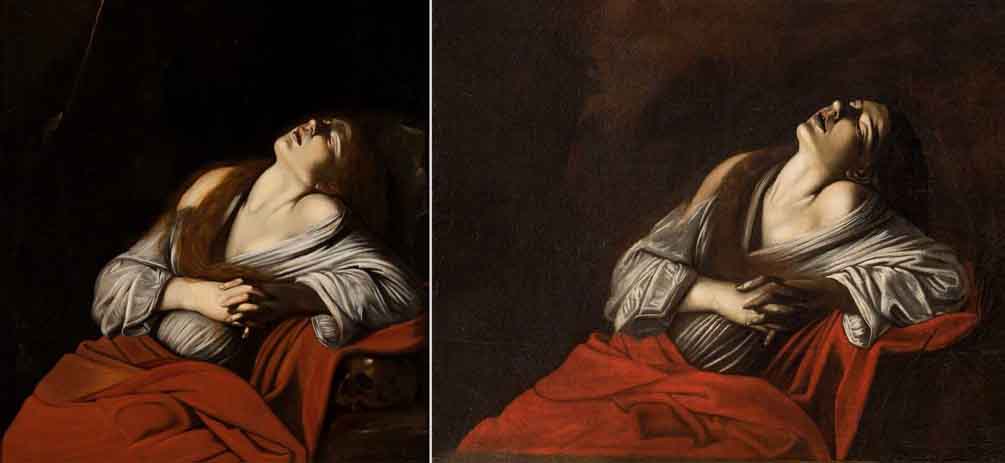A leaky roof may be responsible for the rediscovery of a long-lost Caravaggio masterpiece. In 2014, during an attempt to reach the leaking roof of a 17th century house outside Toulouse, France, the homeowners broke through a door in the attic that they had never noticed before. Behind the door was an oil painting depicting the Biblical heroine Judith beheading Assyrian general Holofernes, while her maid Abra holds open a bag in which his head will be placed. It was covered in dust, but was otherwise in excellent condition. The family called in a local auctioneer to assess the painting. He gently cleaned the painting and identified it as a 17th century painting in the style of Caravaggio.
An expert of Old Master paintings was called in, who spent two years cleaning, conserving and studying the painting. He had it X-rayed and analyzed with infrared reflectography. Key elements and characteristic of Caravaggio’s work were evident, such as a great speed of execution, bold brushstrokes and because Caravaggio never made preparatory sketches first, changes had been performed midstream to the positioning of Holofernes’ right hand and Judith’s face. Two Caravaggio experts examined the painting and agreed that it was an original work by the master, lost for almost 400 years. Another determined it was a copy, albeit a very good one.
Caravaggio had painted an earlier Judith Beheading Holofernes (1598–99) which was rediscovered in 1950 and is now part of Rome’s Galleria Nazionale d’Arte Antica collection in the Palazzo Barberini. He painted the second version in Naples, during the first decade of the 17th century. The existence of this painting is documented in a letter by Frans Pourbus the Younger (a Flemish painter at the Gonzaga court in Mantua) to Vincenzo Gonzaga, Duke of Mantua. The letter, dated September 15, 1607, noted that Caravaggio’s Madonna of the Rosary (now in the Kunsthistorisches Museum in Vienna) was for sale in Naples for 400 ducats. Pourbus also mentioned seeing another Caravaggio painting, a Judith and Holofernes for sale. What Pourbus did not mention was that both works were owned by another Flemish artist (and a good friend of Pourbus), Louis Finson. The Duke was apparently unwilling to spend 400 ducats on the Madonna and a few years later Finson took it with him to Amsterdam, along with Judith Beheading Holofernes. Both Caravaggio works were listed in his will, but after his death in 1617, the Madonna was acquired by a consortium of artists, including Peter Paul Rubens, for a church in Antwerp. The Judith disappeared from historical records.
Is it Authentic or a Copy?
Caravaggio became very famous during his lifetime. While the tempestuous artist never had a school or workshop for students, as was the case with many other masters, he did have followers who copied his works and painted pieces of their own that were heavily influenced by Caravaggio’s style. Louis Finson was one of the first Flemish Caravaggisti, as the followers were known, as was Rubens. Finson had lived in Naples in the early 17th century at the same time as Caravaggio. Not only did he own numerous original works by Caravaggio, he also copied others; one of which was a version of Judith Beheading Holofernes. It was considered a very faithful copy and since the original was considered lost, Finson’s copy was the only existing image of the work. Unlike the Madonna and Judith, Finson did not take his copy to Amsterdam; in fact, it is on display in the Palazzo Zevallos Stigliano in Naples.
One of the most compelling pieces of evidence indicating that the rediscovered painting is authentic are the X-rays. They show that originally, Judith was actually looking towards the face of Holofernes, as she had been portrayed in the 1602 painting. It was only later that the artist changed the painting. Not only would that be typical of Caravaggio, it would never be a characteristic of a copy.
In April, 2016, the work was unveiled to the press and went on display to the public for the first time at Milan’s Pinoteca di Brera, alongside the institution’s Caravaggio masterpiece, the Supper at Emmaus (1605-06). The museum’s director stated that the exhibition “Caravaggio: a Question of Attribution” would give the general public a unique opportunity to assess the controversial attribution for themselves. But the choice to display the unattributed Caravaggio caused controversy and art historian Giovanni Agosti resigned from Brera’s advisory committee in protest against the “uncritical” presentation of a painting that is “not only private property, but for sale.”
The lost Caravaggio has continued to capture the attention of both art world experts and the general public. Unveiled last week at the Colnaghi Gallery in London, it is due to be auctioned off in June. The painting is still shrouded in controversy and with good reason. If it is a genuine Caravaggio, it is estimated to be worth over $100 million.
Caravaggio’s mastery elevated Europe’s understanding of art by the time he died in 1610, at the age of 38, from what may have been gradual lead poisoning from his paint. His arresting interplay of shadows and radiant light heralded the onset of the Baroque style that flourished for another 150 years.
His best works resemble scenes of a macabre theatre stage. The Biblical heroes are played by models he picked off the street, mostly beggars and street urchins, cast against dark backgrounds in a candle-lit glow. He was also a hot-tempered genius, notorious for brawling, even in a time and place when such behavior was commonplace.
The canvas, roughly 57” by 70” depicts the moment the widow Judith beheads the Assyrian general Holofernes, in order to defend the city of Bethulia. She decapitates him after plying him with drink. The more risqué tale depicts Judith as a seducer who first tempts him to bed. If authentic, there are now 68 known paintings attributed to Caravaggio. The auction in June could prove to be as dramatic as Caravaggio’s life itself.





